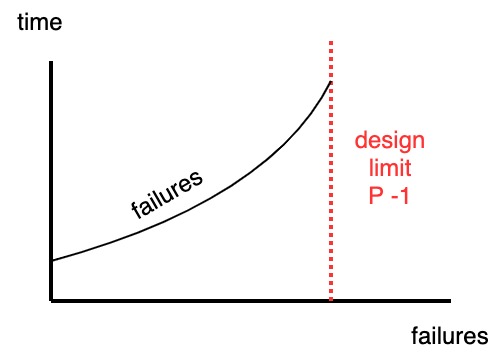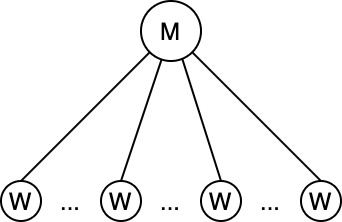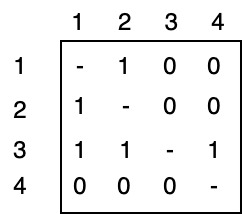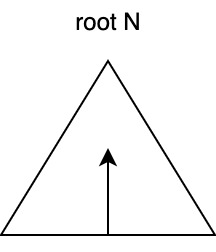10. Redundancy
Feb 15, 2021
Redundancy
- we can achieve fault tolerance through redundancy
- redundancy conflicts with efficiency
- There are two types of redundancies
- space redundancy, e.g. spare tire
- time redundancy e.g. dual rail ethernet, parity memory
- Other examples of redundancy
- retransmission of network messages (time)
- redundant arrays of independent disks (RAID)
- N-version programming: develop multiple versions of the same program to solve the same problem and choose majority result → tolerates minority failures
Consider a decentralized system of \(N\) processors: - 1 processors fails, - now \(N-1\) functional processors - more failures may occur but \(< N\) - we have graceful degradation of service
Assume at least 1 processor survives (\(P-1\))

Example: Network Supercomputing
- SETI@home project: looking for extra terrestial life
- System with master-worker architecture:
- master distributes work
- workers send back processed results

- Several points of failure:
- master is a central point of failure
- workers may be malicious or faulty → master spends ~70% of its time validating processed results
- Redundancy in this system:
- time: master spends time to check same answers repeatedly
- space master sending same task to multiple workers (because they may fail or be malicious)
- This is a DO-ALL problem: there are N tasks and P processors - recall:
- tasks must be similar (same chunk size)
- tasks must be independent
- tasks must be idempotent
DO-ONE Problem
- We have \(N=1\), \(P > 1\) and \(failures \leq P-1\) (at least 1 processor remains)
- Task: write
X := 1to shared memory
One strategy:
- keep a task queue \(TASK[1...N]\), and
- keep a done queue \(DONE[1...N]\)
- then:
if not done task[i] then do task [i]
On a CRCW PRAM
1 2 3 | |
- \(T_P = 1\) task
- \(W = P \cdot T_P = \Theta(P)\)
- \(T_1^* = O(1)\)
On a CREW PRAM
- Attempt to write
X:=1to shared memory P times will generate ~ \(P-1\) runtime errors - On CREW PRAM must use both space and time redundancy
1 2 3 4 5 | |
- \(T_P = \Theta(P)\)
- \(W = P \cdot T_P = \Theta(P^2)\)
These are not good values for time and work → CREW/CRCW are not good models for studying fault tolerance
CRCW Matrix Maximum
Goal: Compute array/matrix max in \(O(1)\) time
Basic approach: - compute max of \(X[1...N]\) - make a binary tree and initialize leaves to values of \(X\) - iterate over tree height: - if left child >= right child, store left child value at parent - if right child > left child, store right child value at parent - Time: \(T_P = \lg N\) - Work: \(W_P = \Theta(N \lg N)\) - note: this is similar to a real-life elimination tournament
Next: all play all tournament

- Number of comparisons is \(N^2\)
- Two games between each → matrix is not symmetric \(X_{ij} \neq X_{ji}\)
- Assign processor to each slot: \(T_P = 1 = \Theta(1)\)
1 2 3 4 5 | |
Steps 1. Do round robin on (as above) - \(\Theta(1)\) 2. Do logical AND on the matrix rows - \(\Theta(1)\) 3. Determine result:
1 2 3 4 5 | |
If there exists a chance of multiple maximum values use lexicographical pair <X[i], i>
instead of simple index.
Number of processors: \(P=N^2\) and \(N = \sqrt{P}\)
| Bounds | |
|---|---|
| \(T_1^*(N) = \Theta(N)\) | Uniprocessor |
| \(T_P = \Theta(1)\) | Parallel time |
| \(S = \frac{T_1^{*}(N)}{T_P} = \frac{\Theta(N)}{\Theta(1)} = \Theta(N) = \Theta(\sqrt{P})\) | Speedup |
| \(W_P = P \cdot T_P = N^2 \cdot \Theta(1) = N^2\) | Work |
Note - Speedup: \(\Theta(\sqrt{P}) \neq \Theta(P)\) → not linear! - Work: \(W_P \gg T_1^*(N)\)
Progress Trees

- Given \(N = P\)
- iterate bottom to top
- general idea:
- at PID:
do task[PID] - progress estimate
- at PID:
While root of progress tree is \(\neq N\): 1. enumerate processors 2. load balance using progress tree 3. do the task at leaf 4. compute progress estimate